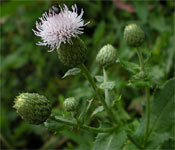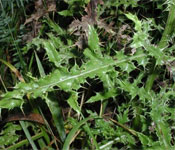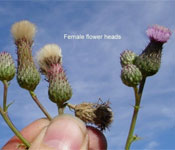- Ag. Service Board
- A.S.B. Members
- About Us
- Annual Report
- A.S.B. Minutes
- Programs, Services
& Rental Equipment - Invasive Weeds
- Crop Diseases & Pests
- Tree Diseases & Pests
- Planting Shelterbelts
- Vertebrate Pests
- Alberta Rat Control Program
- Municipal Tankloaders
- Agricultural Pesticide Empty
Container Collection Sites - Farm Family Awards
- Municipal Photo Contest
- Newsletters
- Upcoming Events & Updates
- Photo Gallery
- Links
Canada Thistle (Cirsium arvense)
Other Names - Creeping thistle
Family - Sunflower Asteraceae
Life Cycle - Creeping perennial
Habitat - conventional tillage, reduced tillage, forage crops, hay fields, rangeland, irrigation, turf, roadsides, waste areas
Key Features
- Deep, creeping roots
- Irregularly-lobed leaves with spines on margins only
- Small male and female heads on separate plants
Seedling
Seedlings have oblong to broadly oval, somewhat fleshy cotyledons. Shoots that emerge from underground root buds lack cotyledons. Both types have ovate first true leaves with sharp spines along the margins.
Juvenile
Canada thistle has deep, horizontal, creeping roots and often forms dense patches. It is largely the spreading underground roots that make control of this weed so difficult. The rosette leaves are usually smooth and irregularly-lobed with a spiny-toothed margin. However, plants vary in the extent of lobing, the length of spines on the margin and in the presence or absence of hair on the undersides of the leaves. Stems are erect, hollow and have many alternate, sessile leaves. The stem surface is usually smooth although spines may be present near the base of the plant.
Mature
Heads are numerous in clusters and are smaller than other thistle species. The disk flowers are pink-purple, occasionally white, and surrounded by narrow, flattened involucral bracts ending in short, weak prickles. Bull thistle is sometimes confused with Canada thistle. Its heads are much larger than Canada thistle, and the bracts are more slender and spine-tipped. In addition, the leaves of bull thistle have short prickles all over the surface. Canada thistle has male and female flowers in heads located on separate plants. The male heads are globe-shaped in contrast to the more flask-shaped female heads. Each female flower is capable of producing a single, tan-colored, slightly curved seed. The seeds have a feathery pappus and are readily dispersed by wind.
- Prohibited Noxious
- Hoary Alyssum
- Spotted Knapweed
- Nodding Thistle
- Noxious
- Common Baby's-breath
- Downy Brome
- Great & Lesser Burdock
- Scentless Chamomile
- Yellow Clematis
- White Cockle
- Oxeye Daisy
- Leafy Spurge
- Common Tansy
- Canada Thistle
- Yellow Toadflax
Juvenile

Mature

Flower

